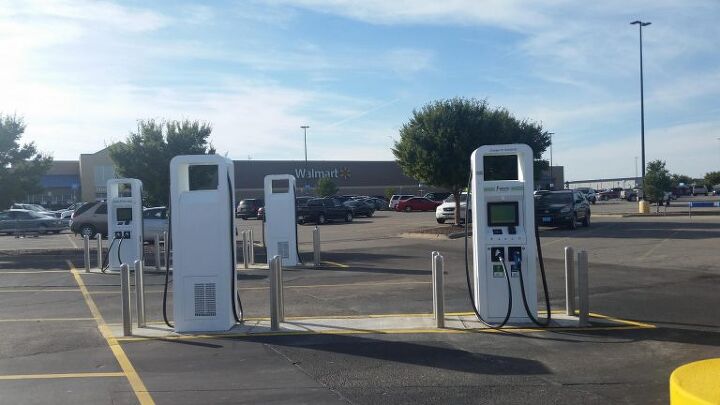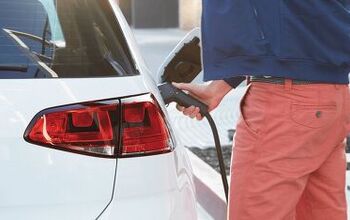VW's Electrify America Sticks With Walmart for EV Charging Expansion

Roughly a year ago, Volkswagen subsidiary Electrify America announced a partnership with Walmart to help proliferate EV charging sites across the United States. Equal parts penance for VW’s illegal diesel shenanigans and shrewd business arrangement, the deal sought to establish plug-in points at 100 store locations in 34 states.
On Thursday, the companies announced the completion of 120 charging stations and signalled their intent to continue collaborating — citing future development programs in the District of Columbia and 46 U.S. states.
Thus far, the auto has primarily focused on selling electric vehicles along the coasts — resulting in the vast majority of charging sites bookending the country. However, in addition to the obvious benefits of hooking up with one of the largest retailers in history, Electrify America says its Walmart partnership provides an opportunity for EV charging stations to make inroads into the heartland. Since its stores are frequently found near major highways, the firm said Walmart is helping to provide a much-needed resource for EV owners hoping to take a road trip.
The stations themselves feature 150 kilowatt (kW) and 350kW DC Fast Chargers, which Electrify America claims can restore 20 miles of range per minute — provided the vehicle is equipped to handle it.
“EV drivers can now travel across the country on major interstates and highways with a large concentration of EV chargers along U.S. interstates,” said Electrify America. “EV charging station placement along many of these routes allow for EV drivers the option to solely recharge at Walmart stores during their travels. Examples of routes include Houston to Chicago via I-45, I-35 and I-44, San Antonio to St Louis via I-35 and I-44 and Washington DC to Savannah, GA via I-95.”
The Walmart deal could help to normalize electric vehicles in parts of the country where they don’t make a lot of sense. While 120 stations spread across 34 states isn’t exactly a deluge, it enhances Walmart’s corporate image and could eventually create a new customer base for the chain. Since EVs can’t refuel like traditional gas-powered vehicles, drivers are often stuck waiting while their car recharges. That effectively makes them a captive audience and, with nowhere else to go, they might decide to go shopping to pass the time. Meanwhile, Volkswagen can fulfill its legal commitments while simultaneously improving the charging infrastructure for the 22 million EVs it hopes to sell over the next decade.
[Images: Electrify America]

A staunch consumer advocate tracking industry trends and regulation. Before joining TTAC, Matt spent a decade working for marketing and research firms based in NYC. Clients included several of the world’s largest automakers, global tire brands, and aftermarket part suppliers. Dissatisfied with the corporate world and resentful of having to wear suits everyday, he pivoted to writing about cars. Since then, that man has become an ardent supporter of the right-to-repair movement, been interviewed on the auto industry by national radio broadcasts, driven more rental cars than anyone ever should, participated in amateur rallying events, and received the requisite minimum training as sanctioned by the SCCA. Handy with a wrench, Matt grew up surrounded by Detroit auto workers and managed to get a pizza delivery job before he was legally eligible. He later found himself driving box trucks through Manhattan, guaranteeing future sympathy for actual truckers. He continues to conduct research pertaining to the automotive sector as an independent contractor and has since moved back to his native Michigan, closer to where the cars are born. A contrarian, Matt claims to prefer understeer — stating that front and all-wheel drive vehicles cater best to his driving style.
More by Matt Posky
Latest Car Reviews
Read moreLatest Product Reviews
Read moreRecent Comments
- AZFelix What could possibly go wrong with putting your life in the robotic hands of precision crafted and expertly programmed machinery?
- Orange260z I'm facing the "tire aging out" issue as well - the Conti ECS on my 911 have 2017 date codes but have lots (likely >70%) tread remaining. The tires have spent quite little time in the sun, as the car has become a garage queen and has likely had ~10K kms put on in the last 5 years. I did notice that they were getting harder last year, as the car pushes more in corners and the back end breaks loose under heavy acceleration. I'll have to do a careful inspection for cracks when I get the car out for the summer in the coming weeks.
- VoGhost Interesting comments. Back in reality, AV is already here, and the experience to date has been that AV is far safer than most drivers. But I guess your "news" didn't tell you that, for some reason.
- Doc423 Come try to take it, Pal. Environmental Whacko.
- 28-Cars-Later Mazda despite attractive styling has resale issues - 'Yota is always the answer.



































Comments
Join the conversation
120 charging stations. Golly, what progress! --This, of course, is the number of gas pumps in a three block stretch on most suburban boulevards.
"The smart water drinker is into cheap $9 per bottle wine too. She’s a cheap date. " Still wasting money though. Tap water is *almost* free. Anyone with hundreds of millions of dollars lying around will live in an area where the tap water is just fine, especially if its charcoal filtered. Tap water is FAR more ecologically friendly too. As to the wine its not to hard to find a $3 bottle of wine that can easily stand up to a $20+ bottle. The difference is more $3 wines suck than $20+ wines. Not a big deal, at $3/bottle its easy to sample a lot to find what you like. The latter is the key, knowing what YOU like and not what others tell you to like. Usually those others are trying to sell you the $20+ bottle. If OTOH you meant $20 restaurant prices that's a different story. $20 is about as cheap as restaurant wines get.